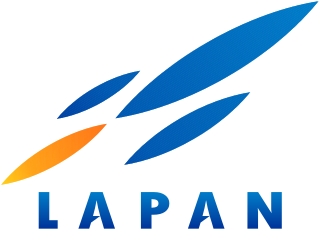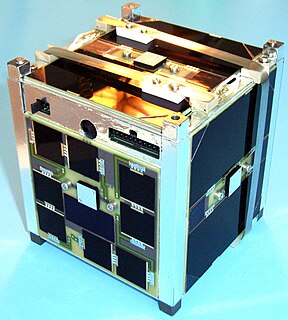Related Research Articles

The Polar Satellite Launch Vehicle (PSLV) is an expendable medium-lift launch vehicle designed and operated by the Indian Space Research Organisation (ISRO). It was developed to allow India to launch its Indian Remote Sensing (IRS) satellites into sun-synchronous orbits, a service that was, until the advent of the PSLV in 1993, commercially available only from Russia. PSLV can also launch small size satellites into Geostationary Transfer Orbit (GTO).

Geosynchronous Satellite Launch Vehicle (GSLV) is an expendable launch system operated by the Indian Space Research Organisation (ISRO). GSLV was used in fourteen launches from 2001 to 2021, with more launches planned. Even though GSLV Mark III shares the name, it is an entirely different launch vehicle.

A payload fairing is a nose cone used to protect a spacecraft payload against the impact of dynamic pressure and aerodynamic heating during launch through an atmosphere. An additional function on some flights is to maintain the cleanroom environment for precision instruments. Once outside the atmosphere the fairing is jettisoned, exposing the payload to outer space.

The Geosynchronous Satellite Launch Vehicle Mark III, also referred to as the Launch Vehicle Mark 3 (LVM3), is a three-stage medium-lift launch vehicle developed by the Indian Space Research Organisation (ISRO). Primarily designed to launch communication satellites into geostationary orbit, it is also identified as the launch vehicle for crewed missions under the Indian Human Spaceflight Programme and dedicated science missions like Chandrayaan-2. The GSLV Mk III has a higher payload capacity than the similarly named GSLV Mk II.

National Institute of Aeronautics and Space was the Indonesian government space agency. It was established on November 27, 1963, by former Indonesian president Sukarno after one year's existence of an informal space agency organization. LAPAN is responsible for long-term civilian and military aerospace research.

This comparison of orbital launch systems lists the attributes of all individual rocket configurations designed to reach orbit. A first list contains rockets that are currently operational or in development; a second list includes all retired rockets. For the simple list of all conventional launcher families, see: Comparison of orbital launchers families. For the list of predominantly solid-fueled orbital launch systems, see: Comparison of solid-fueled orbital launch systems.
RUBIN-8, also known as RUBIN-AIS, is a German space experiment package, built by OHB-System, which was launched by the Indian Space Research Organisation, aboard a PSLV rocket, on 28 April 2008. Following launch, it remained bolted to the upper stage of the rocket in low Earth orbit, where it is used to conduct experiments regarding the relay of AIS data via the Orbcomm and Iridium communication satellite networks.

SwissCube-1 is a Swiss satellite operated by École Polytechnique Fédérale de Lausanne (EPFL). The spacecraft is a single unit CubeSat, which was designed to conduct research into nightglow within the Earth's atmosphere, and to develop technology for future spacecraft. It has also been used for amateur radio. It was the first Swiss satellite to be launched.

BeeSat-1 or Berlin Experimental and Educational Satellite 1, is a German satellite operated by the Technical University of Berlin. The spacecraft is a single unit CubeSat, which was designed to test systems intended for use on future spacecraft, including a new design of reaction wheel. It has also been used for amateur radio, and is equipped with a small camera.
VesselSat-1 was a miniaturized satellite built and owned by LuxSpace, which was operated by Orbcomm under lease. VesselSat-1 and its sister satellite, VesselSat-2 were used by Orbcomm to compensate the functionality of the malfunctioning Orbcomm-QL satellites.
LuxSpace is a European space systems contractor based in Betzdorf in Luxembourg. It was founded in November 2004 as a daughter company of OHB AG, and began operations in January 2005.

Planet Labs PBC is an American public Earth imaging company based in San Francisco, California. Their goal is to image the entirety of the Earth daily to monitor changes and pinpoint trends.

PSLV-C37 was the 39th mission of the Indian Polar Satellite Launch Vehicle (PSLV) program and its 16th mission in the XL configuration. PSLV-C37 successfully carried and deployed a record 104 satellites in sun-synchronous orbits. Launched on 15 February 2017 by the Indian Space Research Organisation (ISRO) from the Satish Dhawan Space Centre at Sriharikota, Andhra Pradesh. According to ISRO, the 101 international satellites were launched as part of a commercial arrangement between several firms and its commercial arm Antrix Corporation Limited, run under the auspices of the Indian Government's Department of Space.

IRNSS-1H was the eighth in the Indian Regional Navigational Satellite System (IRNSS) series of satellites, after IRNSS-1A, IRNSS-1B, IRNSS-1C, IRNSS-1D, IRNSS-1E, IRNSS-1F and IRNSS-1G. It was lost in the launch failure of PSLV-C39 on August 31, 2017.
The Small Satellite Launch Vehicle (SSLV) is a small-lift launch vehicle being developed by the Indian Space Research Organisation (ISRO) with payload capacity to deliver 600 kg (1,300 lb) to low Earth orbit or 300 kg (660 lb) to Sun-synchronous orbit for launching small satellites, with the capability to support multiple orbital drop-offs.

PSLV-C42 was the 44th mission of the Indian Polar Satellite Launch Vehicle (PSLV) program and its 12th mission in the Core Alone (CA) configuration. PSLV-C42 successfully carried and deployed 2 earth observation satellites in sun-synchronous orbits at an altitude of 588 kilometres (365 mi). It was launched on 16 September 2018 by the Indian Space Research Organisation (ISRO) from the first launch pad of the Satish Dhawan Space Centre at Sriharikota, Andhra Pradesh. The two international satellites were launched as part of a commercial arrangement between Surrey Satellite Technology Limited (SSTL) and ISRO's commercial arm Antrix Corporation Limited, run under the auspices of the Indian Government's Department of Space.

The PSLV-C44 was the 46th mission of the Indian Polar Satellite Launch Vehicle (PSLV) program. It was the first flight of PSLV-DL, having 2 strap-on boosters and placed a primary payload Microsat-R and a secondary payload of Kalamsat V2 in Sun-synchronous orbits.

The PSLV-C45 is the 47th mission of the Indian Polar Satellite Launch Vehicle (PSLV) program. The Polar Satellite Launch Vehicle (PSLV)-C45 was launched on 1 April 2019 with a payload of 29 satellites, including one for electronic intelligence, along with 28 customer satellites from other countries.

The PSLV-C51 is the 53rd mission of the Indian Polar Satellite Launch Vehicle (PSLV) program. The Polar Satellite Launch Vehicle (PSLV)-C51 was launched at 04:54 (UTC) / 10:24 (IST) on 28 February 2021 with the main payload from Brazil, INPE's Amazônia-1 and 18 other ride-sharing small satellites. This is the first dedicated commercial launch executed by NSIL.
References
- 1 2 "RUBIN 9.1/RUBIN 9.2/PSLV - Satellite Information". heavens-above.com. Retrieved 2019-05-01.
- 1 2 Ford, Dominic. "RUBIN 9.1 & RUBIN 9.2 - In-The-Sky.org". in-the-sky.org. Retrieved 2019-05-01.
- ↑ "Rubin 9".
- ↑ "Technical details for satellite RUBIN 9.1/RUBIN 9.2/PSLV". N2YO.com - Real Time Satellite Tracking and Predictions. Retrieved 2018-03-11.